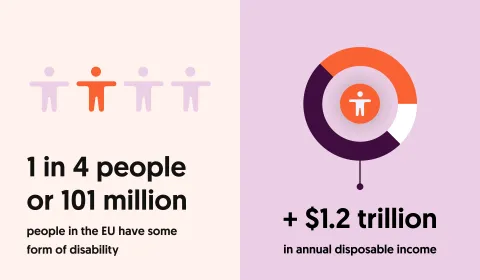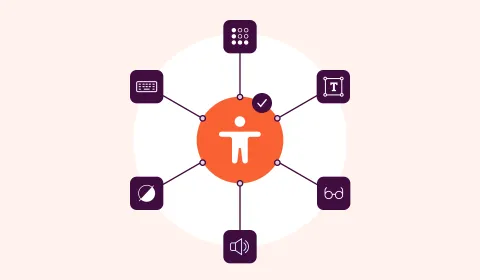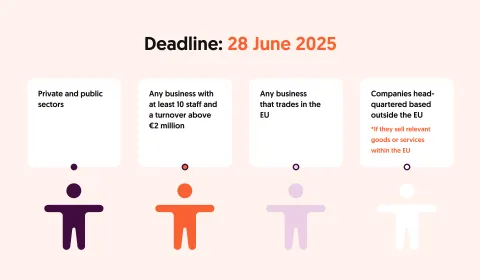Web accessibility: why it matters and how to achieve it

Web accessibility is the practice of designing and creating websites in a way that enables people with diverse abilities to perceive, understand, navigate, and contribute to the web. It involves ensuring that everyone, including people with disabilities, can interact with digital content without barriers. Web accessibility is about to become mandatory.
Why web accessibility is important
As the internet has become an integral part of everyday life, ensuring that websites are accessible is increasingly important. Web accessibility allows people with disabilities to fully participate in digital society, access essential services, and engage in educational, professional, and social opportunities. Despite the fact that web accessibility is highly achievable, many individuals - around 101 million people with a disability in the EU - still face daily barriers to navigating websites effectively.

This is not only a matter of inclusion for people with disabilities but also about equity and fairness in the digital world. By making websites accessible, you ensure that everyone, regardless of their abilities, can interact with your content, products, and services.
Web accessibility benefits everyone
While web accessibility primarily focuses on people with disabilities, it benefits everyone. Many able-bodied individuals also experience circumstances that limit their ability to engage with digital content. These limitations fall into two main categories:
- Temporary disabilities: Short-term impairments, such as recovering from surgery, dealing with injuries (like a broken arm or leg), or having a temporary medical condition. While temporary, these disabilities can make using digital services challenging.
- Situational disabilities: When environmental or contextual factors (like using a phone in bright sunlight, multitasking, or carrying a child) limit someone's ability to engage with digital content. Although these disabilities aren't permanent, they create accessibility challenges that well-designed websites can help mitigate.
Additionally, Europe's ageing population is increasingly impacted by accessibility issues. In the UK, 22% of all people report having a disability, with that proportion rising to 46% among people of state pension age (according to National Statistics). As we age, we all face changes in our abilities, making accessible web design a long-term necessity for everyone.

For businesses and website owners, investing in web accessibility is not just a compliance issue but also a strategic one. It ensures that you can cater to a broader audience and future-proof your digital presence.
How is web accessibility measured?
Web accessibility is measured against the Web Content Accessibility Guidelines (WCAG), a set of international standards that aim to make web content accessible to people with disabilities. WCAG has three levels of compliance: A, AA, and AAA, with each level providing a progressively higher standard of accessibility.
For most organisations, compliance with WCAG 2.1 AA is the goal, as this is the level required by law under many accessibility regulations, including the European Accessibility Act. Meeting WCAG 2.1 AA standards ensures that your website accommodates the majority of accessibility needs.

Compliance and legal obligations
For those who remain unconvinced by the moral and business arguments for accessibility, the legal requirements should serve as a wake-up call. Our article about The European Accessibility Act (EAA) details how it mandates that, by June 28th, 2025, a majority of public and private organisations must ensure their products and services are accessible to people with disabilities on an equal basis with others.
Failure to comply could lead to legal repercussions, including fines and trading restrictions. More importantly, it would leave you behind in a landscape where inclusivity is increasingly becoming the norm.
What does EAA compliance entail?
Under the European Accessibility Act, websites, services, and digital products must be designed to be accessible for people with disabilities, in line with WCAG 2.1 AA standards. Compliance with the Act includes the following key requirements:
- Conformance to WCAG 2.1 AA standards: Websites and digital services must meet the criteria outlined in WCAG to be considered accessible.
- Accessibility statements: Organisations must provide an accessibility statement that details how their websites and services meet accessibility standards. This helps users understand the level of accessibility they can expect and provides transparency.
Like the GDPR before it, the EAA will require significant changes for many organisations. Unfortunately, many companies are still unaware or unprepared for these new regulations.
The good news is that there's still time to ensure compliance, and we have experts and services available to help guide businesses through the process. Moreover, as part of our commitment to fostering a more inclusive digital future, we are now offering free accessibility audits.

In conclusion, web accessibility isn't just about compliance - it's about building a more inclusive, user-friendly web for everyone. Whether due to temporary, situational, or permanent disabilities, accessible design helps all users engage with digital content in a meaningful way, and it offers businesses a chance to reach wider audiences while enhancing their reputation.
Now is the time to take action, not only to avoid penalties but to be part of a more inclusive digital future. Find out more about our Accessibility auditing and remediation services today!
Other highlights
Everything you need to know about The European Accessibility Act (EAA)

The European Accessibility Act (EAA) aims to enhance the accessibility of products and services for...
Web Accessibility and synergies to SEO

The purpose of web accessibility and web design is to ensure that certain groups of people, for...